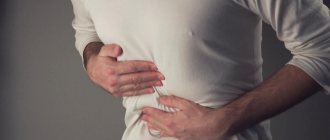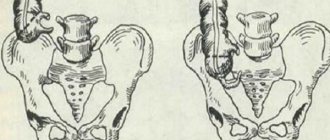If you are worried about pain to the left of the navel, then read the article. It describes all the causes of this condition.
Abdominal pain is the most common complaint of patients. But diagnosing its causes is often very difficult, since the abdominal cavity contains many different organs. In addition, such pain can be a consequence of a failure in a completely different system of the human body.
Read an article on our website about pain to the right of the navel . You will find out why it hurts in this place and what to do.
Pain in the abdomen to the left of the navel indicates the presence of what disease? Find the answer to this question in this article.
Abdominal pain to the left of the navel in women and men: causes, what to do?
Pain in the abdomen to the left of the navel in women and men.
Attacks of pain near the navel, regardless of which side they appear on, are a fairly common occurrence. For example, painful sensations at the umbilical notch after eating can be a signal of spasms of internal organs. What does abdominal pain to the left of the navel indicate in women and men? Here are the reasons:
Appendicitis:
- Pain during inflammation of the appendix overtakes a person unexpectedly and is localized around the navel area.
- Discomfort may periodically intensify, possibly radiating to the right.
- In some cases, with appendicitis, an increase in body temperature is observed, dry mouth, and rapid heartbeat often appear.
Gastroenteritis or inflammation of the walls of the jejunum:
- With this disease, pain often occurs in the navel area.
- In addition to this symptom, nausea, vomiting, and stomach upset may occur.
- There is another characteristic sign - rumbling in the stomach, bloating and flatulence.
- Exacerbation of enteritis, as a rule, is infectious in nature and entails an increase in temperature.
- Exacerbation of chronic gastroenteritis can be caused by a violation of the diet.
Small intestinal diverticulitis:
- This disease is characterized by the appearance of a lump in the navel area.
- This is a diverticulum.
- It usually reaches three centimeters in diameter.
- This is the intestinal lining bulging through the intestinal muscles.
- Diverticula can appear in any area of the intestine.
- In this case, pain will be localized in the left umbilical part of the abdomen.
- An increase in temperature is also typical.
Intestinal colic:
- This disease is often caused by indigestion, constipation, diarrhea, dysbacteriosis and many other phenomena.
- With this diagnosis, pain manifests itself due to spasms of the intestinal muscles.
Chronic jeunitis:
- The inflammatory process affects the jejunum and lasts for a long time.
- The cause of the development of this disease can be intestinal infection, parasites, abuse of spicy foods and alcohol, and immunodeficiency.
- With this disease, pain appears near the navel when the intestinal wall undergoes spasm.
We can come to the conclusion that there are a lot of diseases that cause peri-umbilical pain. In addition, pain of the same nature can be symptoms of completely different diseases for men and women. What to do if pain occurs? Here is the answer:
- If the nature of the pain is constant, then to make a correct diagnosis it is worth contacting a specialist.
- Do not self-medicate - it is dangerous to health and life.
- Try to change your lifestyle and diet.
- Eliminate bad habits.
The most important thing in this case is to find out your diagnosis. To do this, you need to consult a doctor who will conduct a diagnosis - prescribe tests, ultrasound and other necessary procedures. Only after this is a diagnosis made.
Aching pain - what could be the reason
Aching pain in the abdomen to the left of the navel is more characteristic of chronic inflammatory diseases of the gastrointestinal tract. Frequently recurring gastritis, colitis, sigmoiditis without adequate treatment lead to a chronic course, when pain in the abdomen is of low intensity, but it is constant.
Often patients even come to terms with this pain and get used to it. The pain may increase slightly after eating or going to the toilet. Another possible cause of aching pain in the left side of the abdominal cavity is stretching of the spleen capsule, caused by various reasons (viral or oncological diseases, injuries, iron deficiency anemia).
Note! Aching pain in the left side of the abdomen near the navel may be the first sign of a subcapsular rupture of the spleen.
Pain on the left below the navel: causes
Pain on the left side below the navel.
The causes of pain on the left side below the navel can be very diverse. If you are a woman and contact your therapist for help, he will definitely refer you to a gynecologist. The man will need to visit a urologist. Painful sensations to the left of the navel can be a consequence of diseases:
- INTESTINAL OBSTRUCTION
- VOLSION OF INTESTINES
- ONCOLOGY of the intestine, localized on the left side
- PROBLEMS WITH THE ABDOMINAL AORTA
- CROHN'S DISEASE
- ECTOPIC PREGNANCY
- OVARIAN RUPTURE, CYST
- ENDOMETRIOSIS
- KIDNEY INFLAMMATION, etc.
Pain in the navel area on the left side can be caused by irritated, inflamed or infectious intestines. In addition, compression of the nerve that extends from the spinal column and ends in this area can also cause discomfort. If we talk about women's health, the cause of pain in this area can be a rupture during an ectopic pregnancy or endometriosis. In this case, it is necessary to urgently contact a gynecologist.
Many people have a confirmed diagnosis of irritable bowel syndrome . This is a disease of modern people from poor nutrition and dry food and on the go. In some cases, it is possible to relieve pain with the help of medications, but you should remember that you need to visit a doctor for consultation.
Causes of pain
Pain around the navel is likely due to pathology:
- duodenum;
- loops of jejunum and ileum;
- greater omentum;
- stomach (due to its prolapse);
- organs of the urinary and reproductive system.
Pain above the navel is felt due to a pathological process occurring in the stomach or duodenum. Most often this is inflammation, which leads to peptic ulcer. At first, discomfort appears after eating spicy, fried, salty foods, but as the process develops, the pain becomes constant and intense. When perforation of the mucosa occurs, the “acute abdomen” syndrome is formed.
Pain below the navel indicates a problem in the large intestine or in the genitourinary system. Discomfort in this area appears with cystitis, ischemia, irritable bowel syndrome, atherosclerosis, and abdominal aortic aneurysm. Pain near the navel often occurs in women due to cancer of the uterus or ovaries, uterine fibroids, or endometriosis.
As a rule, if the stomach hurts severely in the navel area on the left side, then disturbances in the functioning of the small intestine are detected. Organ dysfunction leads not only to pain and poor digestion, but also due to deterioration of absorption function, extraintestinal manifestations occur, for example, anemia, hypovitaminosis, malarsorption syndrome.
Therefore, if the pain in the navel area is constant or periodic, then you need to consult a doctor to rule out intestinal obstruction, heart attack, jeunitis, umbilical hernia, fermentopathy, oncology, intestinal infection, irritable bowel syndrome.
Aching pain on the left in the navel area: reasons, what to do?
Aching pain on the left in the navel area.
Pain that is aching in nature can signal the process of flatulence. It is accompanied by obstruction of intestinal areas, tumors, problems with the bladder and reproductive system. Also, women who are carrying a fetus experience aching pain on the left side in the navel area. However, this is a normal reaction to stretching of the upper layer of the epidermis on the peritoneum.
In general, there are many factors for such pain, and it is necessary to understand in time how critical the situation is and call ambulance 103. You should consult a doctor immediately if:
- The pain is sharp, accompanied by vomiting and loose stools
- Discomfort is localized in the appendix area
- There is blood in the vomit or stool
If you experience severe pain, you must urgently call ambulance 103. Do not forget that self-treatment can lead to very disastrous consequences. What else needs to be done?
- It is recommended to go to bed until the ambulance arrives
- You need to lie on your back, with your knees bent
- You can put a high pillow under your head
The position of the body should allow the muscles to relax as much as possible. You can apply a warm (not hot!) heating pad or just your palm to the peritoneum.
Pain to the left of the navel and nausea after eating: causes
Pain to the left of the navel and nausea after eating.
One of the main diseases with this symptom is acute pancreatitis. This pathology is considered to be a disease that either occurs suddenly suddenly or develops asymptomatically over a period of time. The most common causes of acute pancreatitis are:
- Blockage of the biliary tract with a stone
- Alcohol abuse
It is worth noting that drinking excessive amounts of alcoholic beverages can lead to a particularly severe form of pancreatitis - pancreatic necrosis. This is due to the fact that the pancreas is especially sensitive to the effects of alcohol. The forms of acute pancreatitis can vary from mild – discomfort in the abdomen, to severe – it is a direct threat not only to the health, but also to the life of the patient. Signs of acute pancreatitis include:
- Pronounced pain to the left of the navel, aching, sharp or encircling in nature.
- Discomfort is often localized in the epigastric region, can radiate to the lower back or shoulder blades, and sometimes spread throughout the entire abdomen.
- General serious condition, possible nausea after eating, vomiting.
- Blue lips, rapid heartbeat.
- Body temperature may be slightly elevated or remain within normal limits.
- The abdomen is painful and tense on palpation. Possibly bloating.
It should be noted that pain during exacerbation of chronic pancreatitis can appear after eating or overeating. Especially after meals, if you ate fatty or spicy foods, drank alcoholic beverages, or other diet violations.
If it hurts in the upper part on the left side of the navel
The appearance of stabbing pain, localized to the left of the umbilical ring, most often indicates diseases of the pancreas. In 65% of cases, patients with these symptoms are diagnosed with pancreatitis. This is an inflammation of the pancreas, in which degenerative changes occur in the tissues of the organ. Any symptoms of this disease intensify after eating food, especially if it contains a large amount of fat. Increased pain can be noticed after a heavy meal, as well as in cases where the break between meals is more than 6-8 hours.
What does pain in the navel area indicate?
Very often, tingling and pain to the left of the navel appear in women who limit themselves in diet in order to lose weight. Starvation diets, as a rule, end in failure and consumption of large amounts of food, which ends in digestive disorders and dyspepsia.
Signs of pancreatitis include the following symptoms:
- pain in the umbilical area, epigastrium or abdominal space;
- sensation of a “lump” in the throat;
- bad breath;
- heartburn;
- nausea (worsens after heavy meals);
- stool disorders.
Signs of pancreatitis
Treatment of pancreatitis includes taking digestive enzymes (Creon, Pancreatin), drugs to reduce gastric secretion (Omeprazole, Omez) and symptomatic therapy to eliminate heartburn and reduce the negative impact on the mucous membranes of the stomach (Almagel). .
Intestinal infections
Diarrhea of infectious origin is another possible cause of pain in the upper abdomen on the left side of the navel. In some cases, diarrhea may be the only clinical manifestation of the disease, but most often it is accompanied by other symptoms. These include:
- increased body temperature;
- signs of general intoxication (chills, weakness, drowsiness, fever);
- vomiting (most often repeated);
- stomach ache.
Diseases depending on the location of pain
Pain during intestinal infections is paroxysmal and is caused by muscle spasms. The intensity is usually strong. To relieve pain in this case, you can use any antispasmodic, for example, Papaverine or No-shpu. To destroy the bacterial flora, broad-spectrum antibiotics (Enterofuril) are prescribed. At the same time, rehydration therapy is carried out using saline solutions (Regidron) and cleansing the body using sorbents (Activated Carbon, Polysorb, Neosmectin).
Volvulus
A very serious pathology, which is a form of intestinal obstruction. Intestinal obstruction is a disease in which digested food cannot move through the digestive tract and remains to rot in the intestines. Pathology is almost always accompanied by severe intoxication. If rotting products and toxins enter the bloodstream, a purulent form of sepsis with signs of a pronounced inflammatory process may develop.
Types of volvulus
Volvulus is the twisting of intestinal sections around its axis. Sometimes the intestine can twist around the mesentery - a ligament connecting the posterior wall of the peritoneum with the intestinal tube (from the parietal layer to the visceral layer). The pathology is always accompanied by pain in the lower abdomen, which can move to the upper part of the left quadrant and concentrate in the umbilical region.
Important! Volvulus is a deadly surgical pathology, so if you suspect this disease (lack of bowel movements for several days combined with a rise in temperature and abdominal pain), you must immediately go to the hospital.
Abdominal aortic aneurysm
The abdominal aorta is a large blood vessel through which blood, enriched with nutrients and oxygen, flows from the heart to the abdominal organs. An aneurysm is a bulge in the wall of a vessel that can rupture the aorta. Alarming symptoms of pathology develop within several hours. The patient experiences a sharp stabbing pain in the upper abdomen and to the left of the navel, dizziness begins, and loss of consciousness is possible. Blood pressure drops sharply; in especially severe cases, blood pressure readings can reach critical levels.
Types of abdominal aortic aneurysm
Pain just above the navel on the left: reasons, what to do?
Pain just above the navel on the left.
This kind of symptom can be both a signal of life-threatening organ diseases, and an insignificant, temporary phenomenon. There are several main organs located in this area:
Causes associated with pain just above the navel on the left are:
Gastritis:
- With this pathology, pain above the navel is most often acute, occurs in attacks, and does not go away for a long time.
- Typically, discomfort with gastritis occurs immediately after breakfast, lunch or dinner, or, conversely, in the case of a long fast.
- Belching, heartburn, and vomiting are also observed.
- Salivation increases, intestinal function is disrupted.
- In addition, weakness, arrhythmia, increased body temperature, and loss of appetite may occur.
- What to do: as a rule, patients with gastritis are prescribed a special diet, antibiotics, and drugs that reduce the secretion of gastric juice.
Peptic ulcer:
- Pain from an ulcer is localized in the epigastrium and radiates to the sternum and back.
- Most often they appear at night, or a few hours after eating.
- The picture is completed by the appearance of nausea, vomiting, loss of appetite, and painful appearance.
- Treatment depends on the level of development of the disease—medical or surgical.
Oncology:
- Symptoms such as pain above the navel may indicate stomach cancer.
- At the very beginning of the onset of discomfort, unpleasant sensations appear weakly, but after a few weeks they can fully make themselves felt.
- Basically, patients complain of symptoms such as aching pain in the navel area, sharp, stabbing discomfort not associated with food intake, acute and constant discomfort, with short breaks.
- In this case, the attending physician may prescribe medications that relieve or alleviate pain.
- It is recommended to use medications regularly, without waiting for a new attack of pain. Sometimes the doctor prescribes several painkillers at once.
Gastroduodenitis:
- This is an inflammation of the mucous membrane of the intestine or stomach.
- Often patients complain of pain on the right side of the navel, pain in the hypochondrium.
- During an exacerbation, pain is localized above the navel, in the area of the duodenum.
- The pain continues for about ten days, after which a period of remission begins.
Pancreatitis:
- This disease is characterized by symptoms of pain after eating, pain in the chest.
- Manifest in the form of burning, cramping pain.
- The development of a necrotic process in the pancreas is indicated by the appearance of acute discomfort, which subsequently disappeared.
- Tranquilizers and analgesics help relieve symptoms.
Cholecystitis:
- This inflammation affects the walls of the gallbladder.
- If you correctly describe the nature of the pain, you can determine the form of the disease.
- The level of organ damage directly affects the expression of discomfort.
- A common complaint from patients is discomfort above the navel on the right, extending to the back, peritoneum, and scapula.
- The pain can be aching, constant, in the form of contractions, colic.
If you have any abdominal pain, you should immediately consult a doctor. Only a doctor can correctly diagnose and prescribe adequate treatment.
Major diseases
If a person has pain in the left side, then in 95% of all cases this is the cause of diseases (acute and chronic) of the gastrointestinal tract and excretory system. Acute pain that gets worse with movement or breathing requires immediate medical attention. Let's look at just a few diseases that can cause pain in the left mesogastric region of the abdomen.
Stomach problems
The most common causes of pain in the left side are stomach diseases caused by poor diet, abuse of junk food and sugary carbonated drinks.
The gastric mucosa, whose function is to protect the internal organ from the negative effects of all products entering from the outside, is not able to fully function, which provokes the development of diseases such as:
- Gastritis - occurs as a result of infection of the body by the bacterium Helicobacter pillory, which settles on the mucous membrane, irritating it and causing pain. Unpleasant sensations appear when food does not enter the stomach for a long time, as well as after a large intake of unhealthy (mainly fried and fatty) food. The pain is aching, the peak of which occurs during the digestion of food, after which its intensity decreases. The disease is caused by poor diet, as well as reduced immunity, which is unable to resist infection by Helicobacter pillory.
- Stomach ulcer – develops against the background of active gastritis, for which there is no treatment. Bacteria, increasing in number, occupy ever larger areas of the mucous membrane, which is corroded, resulting in the formation of bloody ulcerations. The damaged integrity of the mucous membrane causes pain, as well as blood in the stool (the stool turns a rich burgundy or black color). The pain is acute, spastic, intensifies after eating. With an exacerbation of the chronic stage of the ulcer, an increase in body temperature, as well as a complete lack of appetite, is possible.
- Gastroduodenitis is a disease in which infection by the bacterium Helicobacter pillory spreads to the upper part of the duodenum. The pain can be either acute or dull, but constant. The stomach hurts with sudden movements, palpation, and also 10-15 minutes after food enters the stomach.
- Stomach cancer - malignant neoplasms in or near the stomach, can be caused by frequent overeating, as well as eating too salty, spicy, hot and fried foods. It is characterized by an enlarged abdomen, acute pain when pressing on the epigastric region, as well as a general deterioration of the condition.
- Pylorospasm - there is a strong spasm of the stomach, in which the organ is not able to fully perform its functions. Natural blood flow is also disrupted, which can cause severe cramping pain on the left side in the navel area. Occurs due to disturbances in the functioning of the cardiovascular system, as well as with the development of cardiogenic shock.
Stomach diseases may not cause any symptomatic manifestations for a long time, indicating their existence only by the rare sharp occurrence of severe pain.
Pancreas problems
The most serious disease of the pancreas is pancreatitis. It is characterized by the presence of an inflammatory process, the cause of which may be the following:
- long-term medication use;
- abuse of alcoholic beverages, which cause severe intoxication of the organ, disrupting its functioning;
- hormonal imbalances and metabolic disorders;
- frequent overeating, especially at night;
- the predominance of sweet carbonated drinks over pure mineral water;
- parasitic infestation;
- abdominal trauma.
Pain on the left side at the level of the navel in a child: causes, what to do?
Pain on the left at the level of the navel in a child
Pain in the abdomen on the left at the level of the navel in a child can be caused by a wide variety of phenomena - causes:
In most cases, abdominal discomfort goes away after a short period of time. You should contact a specialist urgently if:
- Acute pain in a child continues for two or more hours
- Cramping discomfort
- The child is vomiting and blood or bile is found in the vomit
- There is blood in the stool
If there is pain in the abdominal area, the child should be placed in bed. After a little rest in bed, you will most likely feel better. You can apply a warm heating pad or your palm. It is advisable to offer the child something to drink and not give him food. You should not self-medicate: laxatives or enemas, like other medications, can only be prescribed by a doctor.
When the appendix is inflamed, discomfort is localized in the area of the umbilical notch, possibly radiating to the lower right region. Occasionally, pain may spread to the entire lower part of the peritoneum. Along with these symptoms, vomiting and increased body temperature begin. If you suspect appendicitis, you should immediately consult a specialist. In this case, it is forbidden to warm the stomach or stroke it.
In very young children, signs of abdominal pain are:
- Cry
- Restless behavior
- Decreased appetite
- Sudden leg movements
In addition, it may be that the child lies down with his legs tucked to his stomach. This also indicates that the baby has pain in the navel area. In children under one year of age, symptoms of vomiting, bloating, and the appearance of blood in the stool are possible - this is intussusception. This is a rather dangerous disease that requires immediate medical attention.
Worth knowing: If you do not contact a specialist in a timely manner, the situation may require urgent surgical intervention by a surgeon.
Sometimes acute pain in the abdomen can be caused by an acute respiratory viral infection. You should pay attention to the epidemiological situation in places the child frequently visits, including at home. For pain associated with an acute respiratory viral infection, symptoms will include:
- Increased body temperature
- Feeling weak
- Inflammation of the passages in the nasopharynx
Sometimes a stressful situation or a difficult unfavorable situation in the home can also cause pain in the abdominal area:
- For school-age children, this kind of stress is normal.
- Divorce of parents, other family problems, poor relationships with peers, misunderstandings on the part of adults - all these are stressful situations for a child.
- Children have noticed frequent pain in the morning - this may be due to excitement before the start of the school day.
- Such painful sensations disappear on their own within 24 hours. You can allow your child to stay at home if necessary.
It is necessary to find out the reasons for the child’s unstable emotional state and solve them. It must be remembered that any manifestation of pain in the abdomen in a child requires a medical examination and consultation with a doctor.
Nagging pain on the left, radiating to the navel: causes
Pulling pain on the left, radiating to the navel
Pulling pain on the left, localized in the navel area, or radiating to this area, can serve as evidence of a number of serious intestinal diseases. Here are the reasons:
- APPENDICITIS
- PANCREATITIS
- CHOLECYSTITIS
- PERITONITIS
- INTESTINAL OBSTRUCTION
Female representatives, in addition to this list, may have problems with the ovaries. If discomfort is accompanied by other symptoms, such as high fever, vomiting, then you should immediately contact an ambulance. Before the specialist arrives, you should take the most appropriate position and warm the disturbing area with your palm.
Pain in the lower navel, abdomen, just below the left during pregnancy: reasons, what to do?
Pain at the bottom of the navel, abdomen, just below the left during pregnancy
You should immediately see a specialist if, during pregnancy, in addition to discomfort at the bottom of the navel, just below the left, in the lower abdomen, the following symptoms are present:
- Pulling pain and induration to the right of the umbilical notch
- Increased pain with movement
- Copious discharge from the genital tract
- Rapid pulse
- Fever
In any case, self-medication is not recommended. What to do?
Advice: Consult a doctor. You can call an ambulance. Specialists will advise what to do, or will come to the call to help or take the pregnant woman to the hospital.
To prevent pain of natural origin, the doctor may prescribe:
- Sleeping on your left side
- Diet - no spicy or fried foods
- Prenatal bandage
- Swimming and frequent walks
Do not delay going to the doctor, otherwise it may lead to unpleasant health consequences.
Sharp, strong, stabbing, acute pain to the left of the navel: reasons, what to do?
Sharp, strong, stabbing, acute pain to the left of the navel.
Depending on the nature of the pain, several types are distinguished:
- Colic
- Spasms
- Cyclic, etc.
Sharp, strong, stabbing, sharp pain to the left of the navel can be a signal of many diseases. Here are the reasons:
- INTESTINAL OBSTRUCTION
- SIGMOID VOLVOL
- CROHN'S DISEASE
- PROBLEMS WITH THE ABDOMINAL AORTA
If discomfort does not disappear for 6 hours in a row, or occurs periodically, you should go to the hospital. What is not permissible to do?
- It is forbidden to take medications on your own, without the advice of a doctor - this will lead to serious consequences.
Also, self-treatment can blur the clinical picture and cause harm to health.
What not to do if your stomach hurts?
Any abdominal pain, regardless of its location, should be a reason to consult a doctor. Before examination by a specialist, it is not permitted to:
- apply heat to the sore spot;
- take painkillers (with the exception of antispasmodics if the patient does not have signs of appendicitis);
- eat food;
- give enemas;
- try to empty the intestines using laxatives.
Before going to the hospital or arriving an ambulance, it is necessary to provide the patient with rest and avoid any physical activity. Dry ice can be used to relieve pain.
Pain to the left of the navel is not a specific symptom characteristic of certain diseases, but its occurrence cannot be ignored. There are many reasons that can trigger the occurrence of unpleasant sensations, so it is almost impossible to make a correct diagnosis at home. To determine what exactly caused the pain in the peri-umbilical region, it is necessary to take tests and undergo additional examinations, which may include ultrasound diagnostics, computed tomography, radiography of the peritoneal and chest organs, colposcopy and other types of studies. Colitis in the right side of the lower abdomen, read on our website.
Pain to the left and right of the navel: causes
Pain to the left and right of the navel.
Localization of pain to the left and right of the navel may indicate the presence of some diseases in the body. Here are the reasons:
- Stones in the kidneys
- Diverticulitis
- Constipation
- Lumbar hernia
- Gastritis
To make a diagnosis, it is necessary to determine the nature of the pain and the frequency of its manifestation:
- A nagging pain may indicate problems with the genitourinary system.
- Spasmodic attacks of pain indicate muscle strain and possible pregnancy.
- Aching pain is often found with intestinal bloating, cancer, gynecological or urological diseases.
- Acute pain is characteristic of chronic diseases.
- Pancreatitis, cholecystitis and gastric and duodenal ulcers often cause this kind of pain.
- If the pain is prolonged, then it may be a hernia.
- Cutting and stabbing pains are the cause of diseases that disrupt the proper functioning of the gastrointestinal tract. With such diseases, pain appears after eating, accompanied by sour belching and heavy sensations in the abdomen.
- If pain occurs after physical activity, then this is probably a hernia or increased pressure in the abdominal artery.
Burning pain is often a concern when there are problems with the genitourinary system and digestive tract. In addition, such pain may indicate inflammation of the appendix.
Pain on the left opposite the navel in the intestine when pressing, pressing, palpating: causes, what to do?
Pain on the left opposite the navel in the intestine when pressed, pressed, palpated
There is no need, if discomfort appears in the abdominal area, to press independently into the area of pain, palpate its localization, and so on. This should only be performed by a doctor. Pain on the left opposite the navel in the intestine when pressing, pressing, or palpating can be a consequence of the development of diseases such as:
- Appendicitis
- Chronic enteritis
- Hernias of various types
- Abdominal migraine
If this symptom is accompanied by fever, vomiting, nausea and bile or blood in the vomit, you should immediately call an ambulance.
Important: It is strictly forbidden to take independent measures, regardless of the reasons!
Dull pain on the left side closer to the navel: causes
Dull pain on the left side, closer to the navel
. In order to determine the origin of the pain, you should know what is located on the left side of the peritoneum. There are the following bodies:
- Spleen
- Stomach
- Pancreas
- Part of the intestine
The symptom of dull pain on the left side, closer to the navel, may be associated with diseases of the above organs. In addition, if the onset of a discomforting condition is associated with physical activity, then this is a hernia. There are also a number of diseases associated with a similar symptom. Here are the possible reasons:
- Pleurisy
- Pneumonia
- Duodenal ulcer
If this symptom, like many others, appears, it is recommended to immediately consult your doctor.
Other causes of pain above the navel
Situations when the stomach hurts in the center (at the navel and above), sensations are observed in the epigastric zone, may indicate the presence of other diseases and conditions:
- inflammatory processes in the liver (viral hepatitis);
- increase in the size of the spleen;
- the formation of a hernia in the broad abdominal or umbilical muscles;
- osteocondritis of the spine;
- myocardial infarction;
- development of abdominal aortic aneurysm;
- renal impairment;
- intestinal colic;
- diseases of the female reproductive system.
The appearance of a symptom may be associated with a lack of nutritional culture or a “harmful” diet, the presence of stress, increased physical activity, and pregnancy.
© shutterstock
What diagnosis is carried out if the stomach hurts at the level of the navel on the left?
Diagnosis if the stomach hurts at the level of the navel on the left.
If you experience pain in the navel area, you should consult a doctor such as a gastroenterologist or surgeon. Consultation with doctors in other specialties is less often required. What diagnosis is carried out if the stomach hurts at the level of the navel on the left?
- After a standard interview procedure (history) of the patient, the doctor prescribes laboratory tests.
- The doctor also issues a referral, if necessary, for gastroscopy, colonoscopy, abdominal x-ray, and ultrasound.
- In rare cases, if cancer is suspected, a computed tomography scan may be prescribed.
If you experience pain in the abdomen, do not delay going to the doctor. You should go to the hospital immediately. This will help avoid unwanted consequences and serious complications. Good luck!
In what cases is a doctor needed?
If abdominal pain is caused by a simple indigestion, diarrhea or flatulence, then there is no need to immediately visit the hospital. But, as noted earlier, the cause of painful sensations can be serious pathologies, the appearance of which requires urgent help from a doctor to undergo a medical examination.
Sometimes you need to see a doctor urgently
You should consult a doctor in the following cases:
- sharp pain in the navel area of a pregnant woman;
- loose stool with blood particles;
- decreased blood pressure;
- the occurrence of acute unbearable pain, which is impossible to endure without the use of painkillers;
- frequent vomiting;
- increased body temperature and general fatigue of the patient’s body;
- gradual increase in abdominal pain.
If the pain gradually worsens, consult a doctor
On a note! The appearance of at least one sign from this list should serve as a signal for you to immediately consult a doctor, since in most cases such cases require resuscitation measures or surgical intervention. It is impossible to endure the pain that arises in the hope that soon it will all go away on its own.











